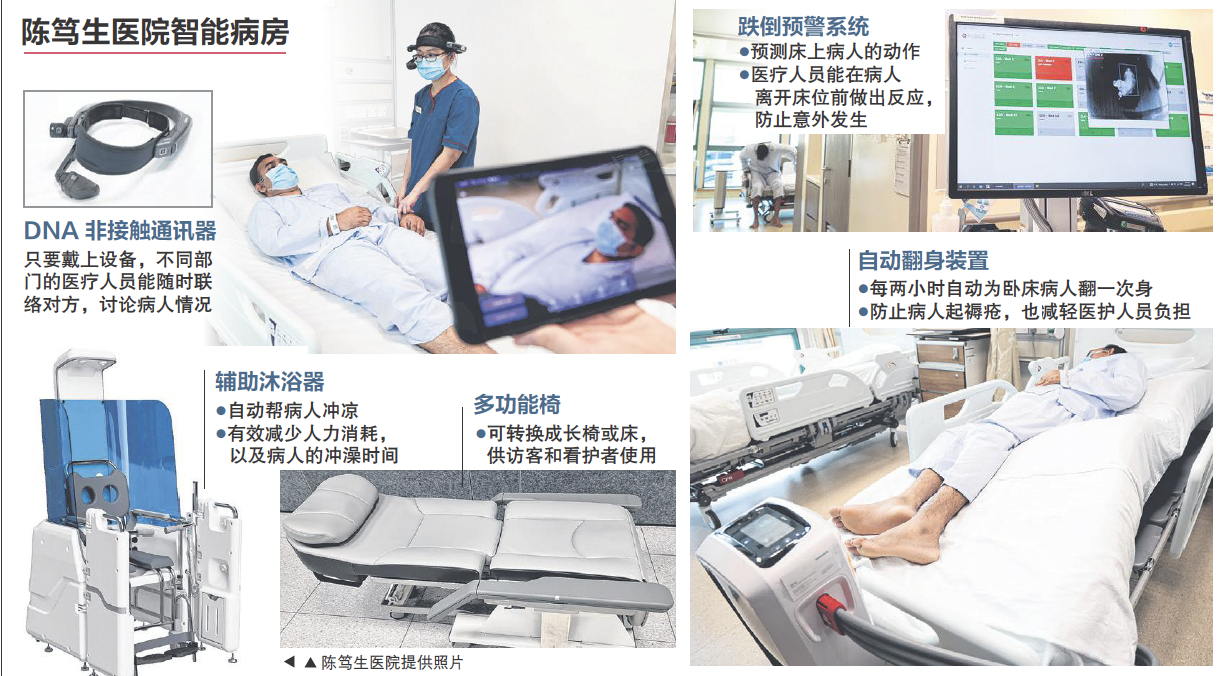 Photography / Li Guanwei Zaobao chart / Leung Kam Chuen
Photography / Li Guanwei Zaobao chart / Leung Kam Chuen
Lianhe Zaobao (14 July 2023)
The DNA contactless communicator developed by Tan Tock Seng Hospital is an innovative tool in the smart ward, which effectively helps medical staff from different departments to discuss the patient's situation at any time and place.
Local hospitals are building smart wards, including using a new communication system to allow medical staff to communicate in a timely manner. This can not only reduce the time for personnel to move, but also provide patients with faster medical services.
During the ravages of the COVID-19 pandemic, local hospitals are facing many challenges in terms of human resources, heavy workload and other aspects.
The Smart Ward of Tan Tock Seng Hospital will start operation at the end of 2022. It mainly uses digital technology, robots and artificial intelligence to improve the various pain points encountered by medical staff at work, reduce their burden, and bring patients more More convenience.
The DNA Hands - Free Communication Device developed by the hospital is an innovative tool in the smart ward, which effectively helps medical staff from different departments to discuss the patient's situation at any time and place. Voice-activated communication, hands-free communication can save eight seconds
Communication between medical staff is crucial, but whenever nurses need to contact doctors or medical staff from other departments, they often have to go through many steps, such as searching for contact information on the computer, picking up the phone to call, and then waiting for the relevant staff to come from the hospital. I rushed to the ward elsewhere, which delayed a lot of medical time.
The communicator, which combines the elements of call, video call and voice assistant, allows users to communicate in a timely manner, and discuss or inquire about the patient's situation at the first time.
According to the introduction, medical staff will wear the communicator on their heads, and they can directly contact the other party through some voice commands such as "call" and the name of the medical staff. The communicator is also equipped with a camera, which is convenient for the other party to observe the patient's condition.
Lin Meiling, the senior nursing manager who leads the smart ward team, revealed in an interview: "The DNA contactless communicator has improved the communication system. Through the new technology, direct voice-activated contact can be made without hands. Doctors don't have to rush to the ward, they can see it through the screen. to the patient's condition."
According to the hospital, compared with ordinary telephones, using this communicator can reduce the communication time by about eight seconds.
Lin Meiling said: "We are still continuing to test. Eight seconds may sound like nothing, but it is very critical in an emergency." Voice-to-text recording of patient data and early warning of fall risks based on patient movements
The DNA non-contact communicator also has other functions. For example, when the doctor can't spare his hands, it can accurately convert the voice into text to help the doctor record the patient's information.
It is understood that the team is still studying how to improve the communicator, including making the voice recognition system more accurate, and modifying its shape design to make it easier for medical staff to wear.
A fall warning system (PreSAGE) is also being piloted in a six-person room in a smart ward. PreSAGE can predict the movement of patients in bed, so that medical staff can respond early to prevent patients from falling or other accidents.
The system has previously been rolled out in single wards and isolation wards in hospitals, but only for one patient.
In order to allow the system to take care of more patients, the hospital is collecting data in smart wards, and it is expected to implement the upgraded PreSAGE system in different wards of the hospital next year.
The PreSAGE system also helps to reduce the manpower consumption of the hospital. Lin Meiling pointed out: "This system can not only prevent patients from falling, but also measure the patient's breathing and body temperature. Nurses do not need to personally measure the patient's temperature every four hours, and have more time to deal with it. Other jobs."
Other features in the smart ward include assistive bathers and robots to help deliver meals and deliver hospital goods, among other things.
However, Lin Meiling pointed out that the new model cannot be fully put into operation in a day or two. Nurses must first understand why there is a need for change and give them enough time to master the operation.
She emphasized that the team will also consider patients' reactions to new technological tools. If they cannot accept them, the team will try to find out and understand the reasons, so as to make the operation more inclusive.